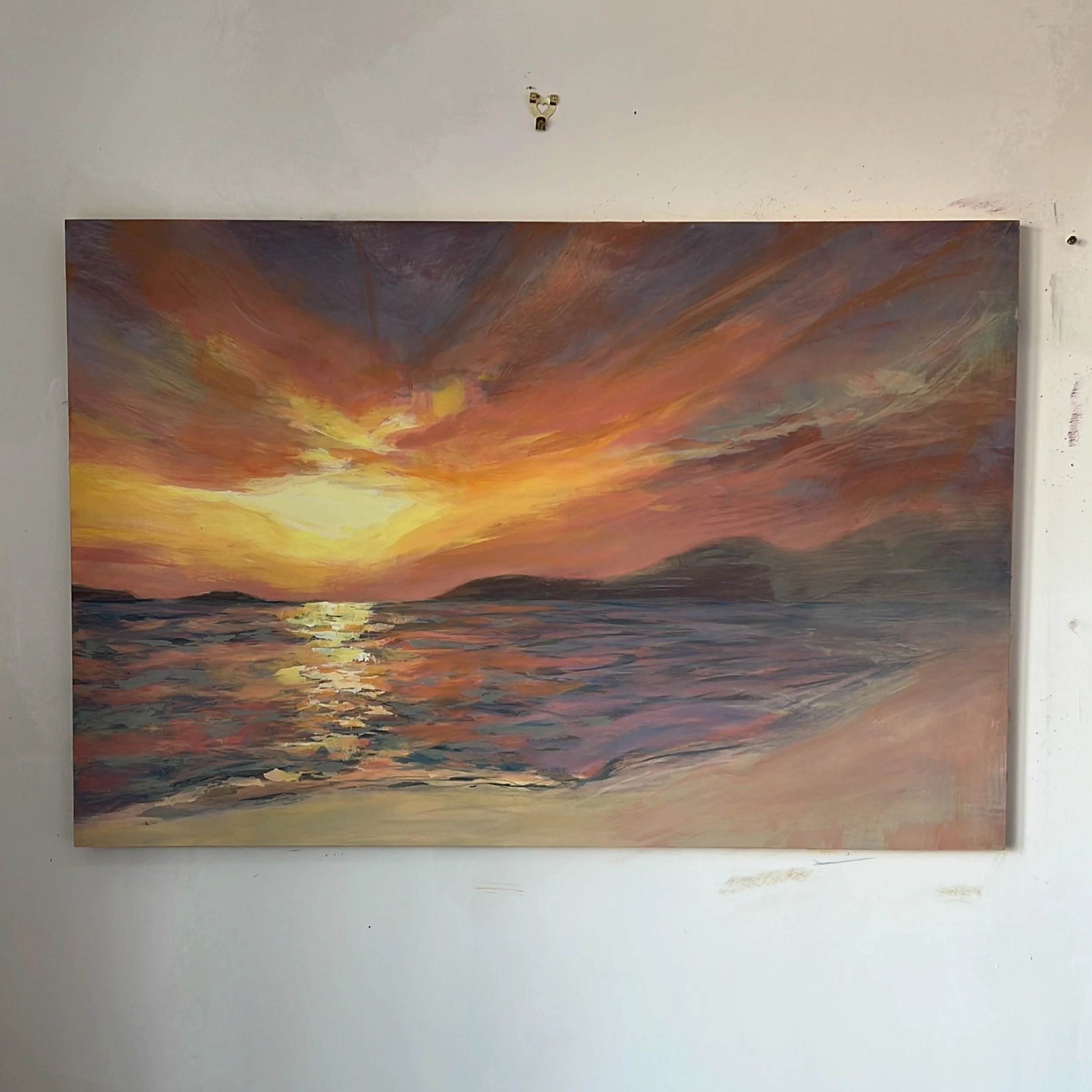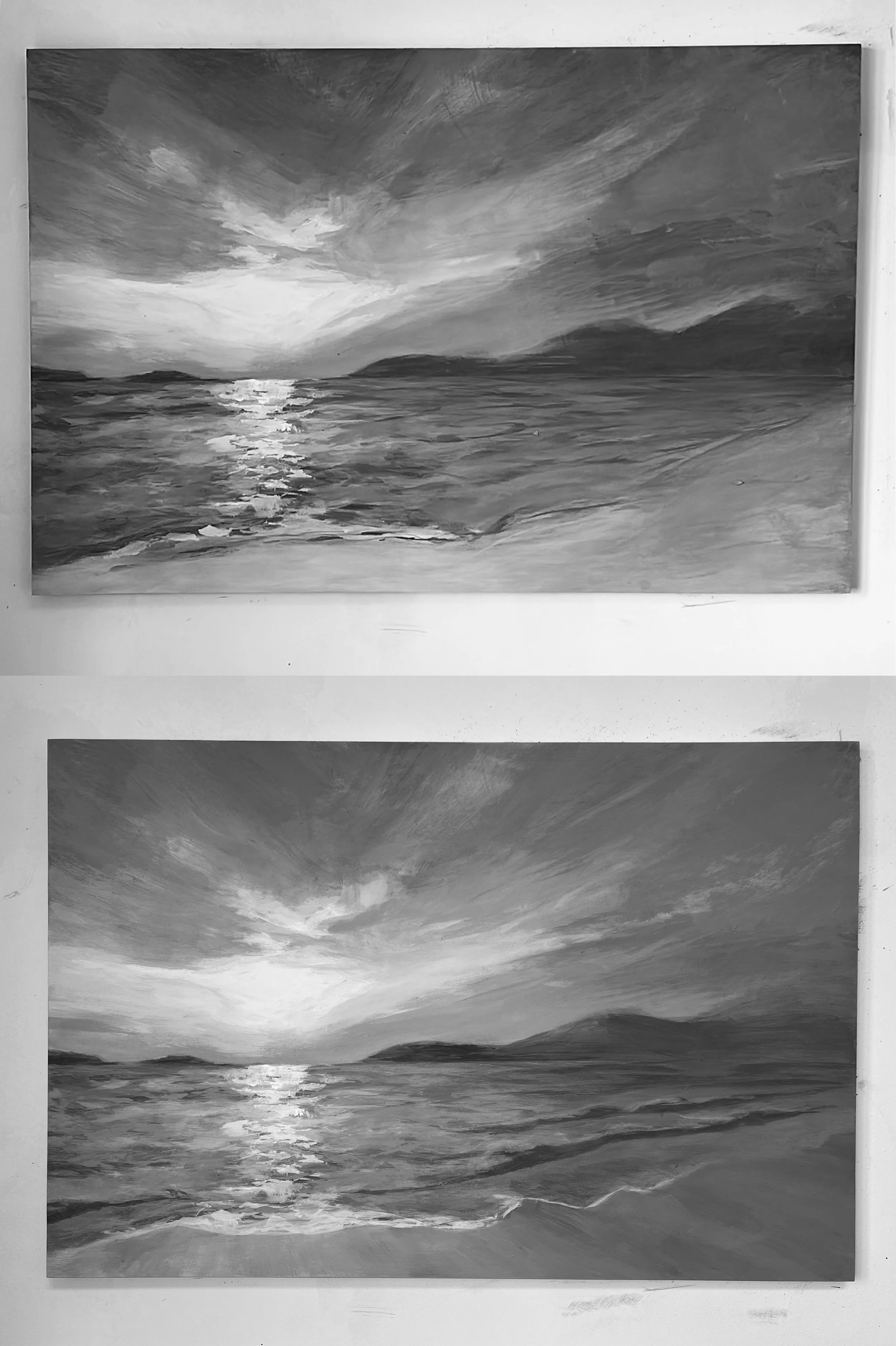Commission Process: ‘Waves of Gold’
A commissioned painting is more than just an artwork—it’s a carefully planned process of design, collaboration, and execution. Here’s an overview of the commission process for ‘Waves of Gold’, completed at the beginning of 2025.
Creating a bespoke piece of art requires meticulous planning, especially when designed for a specific location, and this commission completed at the start of 2025 was no exception. More than just an artwork, a commissioned painting is the result of a carefully structured process involving design, collaboration, and execution, to ensure it seamlessly fit its intended space.
Brief and consultation
My client had a clear vision for a piece that would be positioned on the primary wall of their living room, directly ahead as you enter the room. Since the client was local, we scheduled an in-person consultation to assess the space firsthand. Whenever possible, I prefer to see a space in person, as you can get a feel for spatial and lighting details that cannot be fully captured in photographs. During the visit, I took measurements and evaluated the positioning relative to the surrounding features. After discussing proportions and scale, we determined that a 91 x 61 cm panel would be the optimal size, fitting neatly between the existing wall lights.
The wall space
The photograph captures the space in the evening under artificial lighting, but during the day, the room is bright and airy, filled with natural light that reflects off the lightly painted wooden ceiling beams.
We then moved on to discussing my client’s ideas and preferences for the subject matter and color scheme. They had a strong vision, drawing inspiration from several images that captured meaningful personal memories. The piece was to be a sea and sky-themed composition, combining elements from multiple reference images.
The primary inspiration for the painting was the sky and sea at sunset (1), and this would make up the majority of the colour palette. I wanted to add some more depth and interest to the scene so planned for a shoreline to be in the foreground, with waves gently breaking on the sand (2). Both of these reference images taken during a visit to their family home on the Welsh coast. The sky was going to include some marks and shapes that would be a nod back to their wedding day (3). Finally, they wanted to include some mountains in the distance, a nod to their love of hiking and exploring and the outdoors.
Planning the composition
I began with mapping out a composition taking all the elements above into consideration, in a way that makes sense compositionally. Once I agreed this with the client it was time to start working up the composition on the wooden panel that would become the final piece.
Building up the compositions and first layers
Since my client’s room is bright and calming, they wanted the painting to evoke a sense of serenity and tranquility. I began by gradually building up the piece with light, washy layers to map out the composition, light source, key focal points, and initial value structure. Each subsequent layer reinforced the foundation, further defining the painting’s structure and composition. This approach also allowed me to experiment with the colour composition of the sky in particular, as I was creating an imagined scene rather than working from a direct reference. Through this process, I was able to make decisions about the specific hues, values, and saturation levels the sky would include to ensure that they harmonised naturally within the painting.
Refining the sky and balancing temperature
Once I had established the main structure of the painting, I could begin refining and optimising specific areas individually. The sky, in particular, needed an injection of energy, as it had started to feel overworked and flat. To address this, I introduced looser, more expressive marks to restore a sense of movement and freshness. I also focused on achieving a more effective balance between warm and cool tones, introducing cooler hues into the areas farthest from the light source to enhance depth and atmosphere.
Balancing the composition
At this point, I was satisfied with the sky, but with the focal point positioned toward the left-hand side, the composition felt off-balance. I needed to introduce an element on the right to create visual interest and achieve a more harmonious composition. I experimented with a few adjustments, such as altering the shape of the water on the shoreline and adding rocks to the foreground of the beach. However, neither of these felt right as I wanted to maintain the simplicity of the foreground and preserve the slanted waterline as I felt it helped conveyed a sense of depth from the foreground into the middle ground. I was also cautious not to introduce anything that would compete with the painting’s main focal point.
To subtly restore balance, I refined the right-hand side by defining a series of gentle waves that lead the viewer’s eye into the distance. I also tidied up the shoreline in the foreground, enhancing where the water meets the sand by adding more definition and contrast.
The final touch involved adjusting the colour temperature of the sand and modifying the direction of visible brushstrokes to align with the natural movement of water across the surface—a subtle yet highly effective tweak that brought a natural cohesion to the scene.
Value contrast check
Looking at the painting in black and white allows you to really see the value contrast without the distraction of colour.
The right hand side of the painting lacked value definition in earlier stages, but refining the point where the water meets the sand and the addition of contrast in the waves added enough interest to this part of the painting without taking attention away from the main focal point.
The completed painting
Finishing touches and framing
The painting was mounted in a simple white wooden frame. I painted the edges of the panel a bright pink to allow warm light to subtly radiate into the shadow gap. It’s small details like this that help to unify a piece, creating a sense of cohesion and quality. It’s these finishing touches that complete the painting, ensuring that every element feels intentional and connected.
Creating a commissioned piece of art is an exciting and meaningful journey—one that carries a deep sense of collaboration and responsibility. It’s a fusion of visions, where I strive to bring another person’s memory or idea to life. The process is a challenge and an honour, offering the opportunity to create something deeply personal—an artwork that not only holds significance for the client but also carries a piece of my creativity and passion.
I hope this gives you a glimpse into my process. If you’d like to discuss bringing an idea to life, do get in touch.



















